Crimea
Crimea (Russian: Крым, Ukrainian: Крим, Crimean Tatar: Qırım, Къырым) is a peninsula jutting into the Black Sea. We treat it here as a region of Russia because Russia controls the area, but see also the boxed text below.
The Crimean Peninsula is connected to Ukraine by two narrow necks of land, making it more like an island with two natural land bridges than simply a bit of land jutting out into the sea. A ferry-boat connects over the 5 km broad Kerch strait, to the Taman Peninsula in mainland Russia.
|
The political status of the Crimea is a controversial and sensitive issue; Russia has controlled the region since March 2014, annexed it and considers it Russian territory, but Ukraine still claims it and the U.N. and most other governments support its claim. This is only one of a complex set of issues in an ongoing dispute between Russia and Ukraine. Wikivoyage does not take a position on these disputes; we aim to deal only with the practical issues of travel:
Some governments have travel advisories for the area: US, UK, Canada, Australia, NZ, Ireland |
The peninsula was the site of the "bloodless" Russian invasion of 2014, where outnumbered and infiltrated Ukrainian troops for the most part had no choice but to surrender the entire Crimea to Russian troops. There is not yet a common name for this event.
Regions
- The Coastal Beach Cities -- The coastal beach cities are very hospitable to tourists if you speak Russian. Accommodation is plentiful and prices range widely, depending on location and accommodation type. Despite there being nothing particularly cheap listed online, touts offering cheap rooms and apartments are a good way to find budget accommodation. Also look for houses advertising accommodation: they will usually have a large white sign stuck on the door that has about three words written in Cyrillic (unfortunately wording varies). During summer expect the beaches to be packed with mostly Russian tourists. Behind the beaches the Coastal Mountains tower up to 1,500 m above the towns.
- The Coastal Mountains -- The mountain area that stretches from the coast to about 70 km (43 mi) inland contains some very pristine untouched nature. The mountains are formed by ragged limestone that has been shaped into high peaks with canyons, cliffs and valleys transecting them in all directions. Expect a great adventure if you want to go hiking here, but also expect to rough it. Camping sites are few and far between so you'll probably have to just find one of the many secluded fields to camp in. The area has numerous caves as well as small lakes. There are almost no marked trails
- The Sea of Azov and Kerch -- Gateway to Russia across the Kerch Strait.
- The Inland Plains -- Fairly flat farm land like much of the rest of Ukraine and Western Russia. Looks nice while passing through it by train.
Cities
- 🌍 Simferopol — The capital. The train station is very clean and beautiful. For the most part this is a place of transit to the coast or to the mountains. It is famous for having the world's longest trolley bus service of 86 km (53 mi).
- 🌍 Alushta — The first beach city on the way to Yalta from the west, this city does not have much in it except old boat docks that have been transformed into beaches.
- 🌍 Bakhchysarai — A former Crimean capital, in a canyon between Simferopol and Sevastopol, with a wealth of interesting sites to see including the Crimean Tatar Khan's palace, the cave cities (Kachi-Kalion, Chufut-Kale, Eski-Kermen, Shuldan) and the Armenian monastery, built in a cave.
- 🌍 Feodosiya — Feodosiya is 100 km (62 mi) to the east of Simferopol. From the outskirts it looks like an urban industrial disaster but once past the factories it has a very nice old town. Very similar to Odessa in architecture but just on a smaller scale. Home to the Ayvazovsky Picture Gallery.
- 🌍 Kerch — Your last stop before reaching the eastern edge of the Crimea and heading across the straits into the rest of Russia.
- 🌍 Shcholkine
- 🌍 Sevastopol — A major port for the Russian Black sea fleet. Given the title 'Hero City' for its resistance to the Nazis during World War II. Numerous monuments to the past's military exploits. Nice shops.
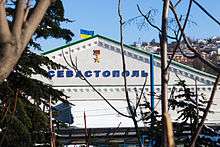
- 🌍 Yalta — A very beautiful city containing many of the Russian Czar's palaces and other great monuments. Twinned with Margate in England amongst other places. Yalta is a tourist hotspot, which contains a mixture of Soviet hotels and modern high rise apartments. Yalta was once the main holiday destination for many Russians before they were allowed to travel outside the Soviet Bloc.
- 🌍 Yevpatoria — an ancient city with more that 2500 years of history, named after King Mithridates VI "Eupator" of Pontus, a contemporary of the Roman Empire.
Other destinations
- The Bolshoi (Grand) Canyon
- 🌍 Alupka — Rocky beaches, home to a number of dacha's and the magnificent Vorontsov palace, where Churchill stayed during the Yalta Conference in 1945.
- 🌍 Balaklava — famous for the Crimea War of the 1850s, the infamous Charge of the Light Brigade, and home to a former secret Soviet submarine base.
- 🌍 Koktebel — Located between Feodosiya and Sudak, this small town has a great beach area that has a carnival type environment. It sits below a spectacular wilderness area to the west that you can only visit on a guided tour.
- 🌍 Sudak — A beautiful coastal city with the remains of a very old Genoan fortress.
- 🌍 Massandra — Small city near Yalta with the Massandra Palace and the fаmous winery "Massandra".
- 🌍 Livadia — Small city near Yalta where the Yalta Conference that divided Europe into spheres of influence was held in the Livadia Palace in 1945.
Understand
This region features many landscapes: Crimean steppe (or prairie) to the East and North, Feodosia's sandy beaches, undulating hills of vineyards and fruit trees, castles reminiscent of Bavaria cling to cliffs plunging into the warm sea and there are forested mountain ranges with fabled cave cities to the West.
Crimea observes Moscow Standard Time (MSK).
Media
Ruth Maclennan's film Theodosia is a good introduction to the place of Crimea in the Russian psyche.
When you get to Crimea you can buy the local guide book Time to Come to Crimea! (in English and Russian) at one of the many small booths on the street.
Weather and water
The weather in Crimea during the summer season is very much Mediterranean. Expect relatively hot weather and lots of thunderstorms that come and go. Hot and very humid at night. In the winter snow can cover the mountains and make the roads almost impassable
The water is fairly warm, although not as warm as the Adriatic. The water is clean and clear, although also a bit less than the Adriatic.
History
During the Crimean War between 1854 and 1856, Britain and France invaded the Crimea to support Turkey in a dispute with Russia. During this war, Florence Nightingale more-or-less invented modern nursing, and William Howard Russell, modern war reporting. The most famous battle was at Balaklava, near where the invasion force landed; part of that was the infamous Charge of the Light Brigade (Russell's phrase). A woolen head garment is named for the town, as is the Balaclava melee, a cavalry training exercise using wooden swords.
Genealogical research
All historical documents, including birth records, for all nationalities (Russians, Tatars, Jews and Germans), are kept in the National Archive in Simferopol.
You may contact them by email at archive@home.cris.net although the best way to receive a response to your email will be to send it in Russian. The archive is open from 08:00 to 17:00 Monday through Friday. Individual access to much of the archive is not permitted, although for USD30 you can pay someone to who works in the archive to do the work for you. Nobody in the archive speaks English so either be prepared to speak Russian or bring along a translator.
The archive is at No. 3 Keckemetckaj, which is the main street running directly east from the train station, in Simferopol (about 1 km).
The archives and its staff are not accustomed to foreigners, so be prepared to explain to the guard at the front desk what it is you want to do.
The Lutheran Church in Simferopol supposedly has a list going back to the early 1800s of all German families who emigrated to Crimea under Catherine the Great, or so it was said at the Archive. This information has not actually been confirmed at the Lutheran Church. For that matter, finding the Lutheran Church, though mentioned in the guide book, is actually a quite difficult task.
The city of Feodosiya has a Jewish Community Centre that is very active in doing research on the Jewish community of Crimea. You may contact them at ruslilya3@mail.ru, they can communicate in basic English (so you can send the email in English) but more than likely the response back will be in Russian.
Talk
The three official languages are:
Russian is the lingua franca, and the overwhelming majority of the local people are, or define themselves, as ethnic Russians. Try to learn a little before you come, even if it's just getting familiar with the Cyrillic alphabet, as few people speak or understand English.
Ukrainian About a quarter of the population are ethnic Ukrainians. Generally the Slavic people that you meet will likely be pro-Moscow and therefore may not appreciate being spoken to in Ukrainian, although if you don't know either language well, you may not be able to tell the two languages apart.
Crimean Tatar (of which the Yalıboylu dialect is mutually intelligible with Turkish) is widely spoken by the indigenous Crimean Tatars, who constitute about 12% of the population. Given the mass deportation during Stalin's rule, older Crimeans may also speak Uzbek.
German was the main foreign language taught to Soviet school children and many people will know a few words.
Some of the street signs in Yalta are in English from the time of the Yalta Conference in 1945.
Get in
After the annexation of Crimea by Russia, Russian immigration and custom agencies started operating in the peninsula's ports of entry, and foreign citizens now need regular Russian entry visas to visit Crimea.
Since December 2014, it has not been possible to travel from Ukraine to the Crimean peninsula by public transport. Unless you hold a Ukrainian passport, you will need a special permission from the Ukrainian government in order to cross the "Ukraine-Crimea" border by foot.
Officials of the Ukrainian border authorities announced in 2014 that an entry to Crimea not from the mainland Ukraine will be considered as an "illegal entry to the territory of Ukraine". In practice, it means that if, after entering Crimea from mainland Russia, a foreign citizen tries to enter the mainland Ukraine, he/she will be subject to a administrative or criminal prosecution (a fine, a possible denial of entry to Ukraine or an imprisonment).
Since March 2015, EU cruise ships have been prohibited from calling at Crimean ports due to EU economic sanctions.
By bridge
The Crimean Bridge, over the Strait of Kerch from the Taman Peninsula, has opened for car, light truck and bus traffic in May 2018. Heavy truck traffic is planned to be added in October 2018 upon the completion of the security checkpoint stations on both sides. As of July 2018, the construction of the parallel railroad bridge is underway, due to open in 2019.
By train
The rail ferry between Kerch and Russia's Krasnodar Krai is only used to move freight cars. Direct train service exists between Rostov-on-Don and Simferopol, but it entails two separate trains: one bringing passengers to the ferry on the Taman Peninsula, and the other one running between the harbor on the Crimean side and Simferopol. It is more common, though, to use a combined ticket sold by Russian Railways. This ticket includes a train to Krasnodar or Anapa and the bus service from Anapa/Krasnodar via Crimean Bridge to Crimean cities.
By plane
There are flights to Simferopol from Moscow, St. Petersburg, and many other Russian cities. No international flights operate to Simferopol. The nearest airport having international flights is Krasnodar in mainland Russia.
By bus
Frequent bus service connects Crimea to mainland Russia. The buses operate to various destinations in Krasnodar Krai including Krasnodar, Anapa, Novorossiysk, and Sochi. All buses cross the Strait of Kerch by the Crimean Bridge from the Taman Peninsula. Passengers should expect disembarkation at the security checkpoints before entering the bridge from each side.
By ferry
Frequent passenger and vehicular ferries operate across the narrow Strait of Kerch, between Kerch's Port Krym and Port Kavkaz on a spit of the Russian mainland. (Schedules and fares in Russian ). As of April 2014, the one-way passenger ticket is RUB162 for adults and RUB81 for children; transporting a car costs RUB1190-1688. (Ferry info updates for 2014, in Russian) Ferry service is subject to weather conditions and can be interrupted for 1-2 days in a row because of bad weather. Expect queues and long waiting times during high season, especially in the end of August.
Freight services run between several major Crimean ports and the harbors of Krasnodar Krai (Anapa, Novorossiysk, Feodosiya). Most of these ferries will not accept personal cars or individual passengers.
Get around
You can get anywhere in Crimea by mini bus. You can also go by taxi. Prices vary; be prepared to haggle a fare as you will always find someone to do a deal with. Many private citizens also work as pseudo taxi drivers; sometimes it is difficult to tell. Taxis range from modern comfortable cars to 1950s gas-powered Soviet cars!
Frequently while travelling in the country if you look like a foreigner (for example with a backpack) and you are standing on what passes as a 'major' road people will stop and ask if you want a ride... for a price. Fortunately that price is usually quite small to go some very long distances.
The road system in Crimea is in very poor repair; expect huge potholes. There is a very strict zero tolerance policy for drinking and driving. Police patrols are frequent as well as roadside checks for documents, but the death toll on the roads remains very bad.
As of July 2018, the construction of the federal highway Tavrida, from Kerch and the Crimean Bridge on the east coast to Simferopol, Bahkchisaray, and Sevastopol on the west coast, is underway; it's due to open as two-lane (one lane in each direction) in the end of 2018 and four-lane (two lanes in each direction) in the end of 2020. Many streets, junctions, and local and intercity roads have seen extensive repair and widening work in the past several years.
See
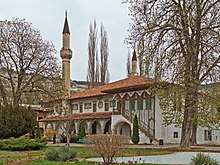
- The Khan's Palace -- The Khan's palace is in the small mountain village of Bahkchisaray half way between Simferopol and Sevastapol. The Khan's palace was the seat of the Tatar rulers of Crimea dating back to 1443. With the Ottoman conquest of Crimea in 1475 the Khan's became a vassal state of the Ottoman Empire but were left as the rulers. After the Crimean war with the victory of Russia all of the Khan's were made Russian nobility but the capital of Crimea was moved to Simferopol. The palace grounds include impressive gardens, several old mosques including cemeteries, a harem and of course the palace itself. You can take a guided tour of the palace but only in Russian.
- Chufut Kale Cave City -- An hour and a half walk up a beautiful canyon from the town of Bahkchisaray you will find the Chufut Kale cave town dating back to the 6th century. It is located high up in the cliffs so the walk is a bit strenuous but not overwhelming. It is a city of what appears to have been several thousand people who built/dug their homes into the limestone rock. The city was abandoned in the 19th century. There are some other cave cities (about 14), completely different as far as size and picturesqueness concerned
- The Bolshoi Canyon -- The Bolshoi Canyon is on the opposite side of the mountain range that Yalta sits below. It will take about an hour and a half to get there by car from Yalta. It can also be reached from Bahkchisaray by hitch hiking or minibus. Bolshoi means 'grand or large' in Russian. After reaching the entrance to the park you will have to pay a small fee (USD2) to start down the trail. From there it is about an hour hike into the canyon along a small mountain stream. You never actually end up getting a perfect view of the canyon as you are also down in the middle of it surrounded by lush vegetation but it is impressive all the same. The trail ends at a small picnic area where a local man is selling awful wine and really good fried food. There is a small waterfall and a pool where you can do some minor diving/jumping. You can continue further up the stream without the trail but it is a bit more rough going.
- Caves -- There are three caves equipped for easy access: Krasnaya, Mramornaya, Emine-Bayır-Hosar. And there are a lot of undeveloped caves attractive to speleologists.
- The Swallow's Nest an architectural folly, now an Italian restaurant.
- Livadia Palace -- A former summer palace to the Russian tsars and famous setting for the Yalta Conference.
- Massandra Palace -- Another former Tsarist palace, which looks a bit like a French Chateau, once visited by Stalin who declined to stay there as he did not feel very safe.
- Gurzuf, a small pretty coastal town that retains (perhaps has regained) its old Ottoman characteristics. Close to Yalta off the road to Alushta, its climate is very similar to French Riviera. Gorgeous views and clean warm sea.
- Inkerman Cave Monastery -- A cave monastery in a cliff rising near the mouth of the Black River, in the city of Inkerman, administered as part of the sea port of Sevastopol. It was founded in 1850 on the site of a medieval Byzantine monastery where the relics of St. Clement were supposedly kept before their removal to San Clemente by Saints Cyril and Methodius.
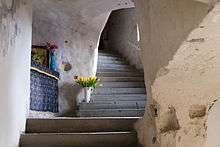
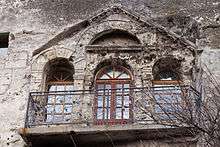
- Chersonesus - An ancient Greek colony founded in the 6th century BC in the southwestern part of the Crimean Peninsula, known then as Taurida or Taurica. Nicknamed the "Ukrainian Pompeii" and "Russian Troy", the ancient city is on the shore of the Black Sea, at the outskirts of Sevastopol. Locally known as Khersones, the site is part of the National Historical-Archeological Museum Zapovednik. (In Russia and the former Soviet Union, a zapovednik is a protected area which is kept "forever wild" for conservation purposes.)
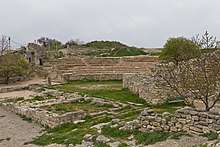
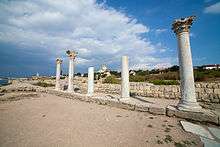
Do
- Hiking in Crimea is wonderful. There are very few other backpackers and almost no clearly marked trails (as in posted signs) so you're going to be roughing it. The trails themselves though, appear to be well used. In the mountainous region though you can pretty much pick any two small towns and hike between them and be assured of an adventure. Campsites are few and far between but there is lots of open space for camping; be environmentally sensitive of course about the place you choose to camp. For a brief description of a hike see Bahkchisaraj
- Koktebel Jazz Festival. Takes place each year in August/September, with some of the acts performing on the nude beach. Day ticket around USD12.
Buy
The Russian ruble has replaced the Ukrainian hryvnia as the legal currency of Crimea.
Choices are limited for banking. All Ukrainian banks have had to stop operations on the peninsula; as of 2015 the US-owned Visa and Mastercard are not accepted, and no major Russian banks operate in Crimea, due to the risk of being targeted by international sanctions. Sberbank, the Russian state-controlled bank, has stayed out of Crimea but is backing a new Russian-domestic credit card "Pro 100" (pronounced “pro-sto”) which is slowly being introduced. Most often, the only practical means of doing business is with cash.
Eat
Street food can be delicious in Crimea, if somewhat heavy. Definitely try some local Tatar specialties such as chebureki (Russian: чебуреки), from an outdoor stand or a cheburechnaya (Russian: Чебуречная, "chebureki joint"). These are succulent half-moon shaped meat pies, usually filled with lamb or beef (Crimean Tatars, being Muslim, do not eat pork), and deep-fried in aromatic sunflower oil. Samsa are also good, hot pastries filled with mince meat and chopped onions.
Try manti (Russian: манты), which are steamed lamb-filled dumplings, often served with adjika (Russian: аджика), which is a very hot red chilli pepper paste.
Try lyulya-kebab and shashlik (Russian: люля-кебаб and шашлык), which are kebabs and charcoal-grilled skewered meat. If you can find pork shashlik, definitely try them. You will have more success with this in a Russian-run restaurant, as pork is not served in Tatar restaurants.
Find a good Tatar restaurant and try the lagman (Russian: лагман). It's an incredibly rich, thick lamb soup with vegetables and long homemade noodles.
The ice cream sold at the beach includes a simple one called molochnoye (Russian: молочное, "made of milk"). It's white, but it's not vanilla-flavoured. It tastes like sweet milk.
If you see women walking up the beach selling something from buckets, it's probably paklava (Russian: паклава, baklava). This paklava is like nothing you have ever had before. It's thin layers of homemade dough, put together to resemble big flowers, deep-fried and covered with nuts and honey. It's absolutely heavenly.
Find a pastry shop and try the trubochki (Russian: трубочки, "little trumpets"). A trubochka is a cornucopia shape of short pastry filled with meringue and sometimes dipped in nuts. Delicious with chai (Russian: чай, tea).
Drink
The beer in Crimea is outstanding and cheap.
Crimea is a wine-producing region. Most of the wine produced here, at the famous Massandra Palace winery and in Koktebel', is dessert wine in the style of Port or Madeira. Unwary foreigners might buy a bottle of what looks like red or white wine in a kiosk and find it undrinkably sweet. That's because it's meant to be sipped, in very small quantities, not drunk like a Merlot. If it's regular wine you're looking for, avoid anything labelled Портвейн (Portwine), Мадейра (Madeira), Мускат (Muscat), Токай (Tokay). For table wines, ask for sukhoye vino (dry wine) or look for labels such as Совиньон (Sauvignon), Каберне (Cabernet), and Ркацтели (Rkatseteli), or look for Georgian wines, which are delicious and plentiful.
Try the regional sparkling wine, produced at Noviy Svet (Russian: Новый Свет, "New Light"), near Sudak. It's labelled "Шампанское" (Shampanskoye, champagne). Try to buy it somewhere reputable, though, because there are knock-offs. Noviy Svet is a very beautiful spot; you can tour the caverns where the wine is aged.
If you're not going anywhere else in Russia and Ukraine, try kvass (Russian: квас). It's a very refreshing non-alcoholic drink made of fermented wheat, the traditional drink of farmworkers in the bread-basket of Ukraine, prized for its restorative properties.
Try the local kefir (Russian: кефир), a cultured-milk beverage. When ice-cold, it's extremely refreshing on a hot day.
If you're feeling adventuresome, you might look for kumys (Russian: кумыс or кымыз), which is fermented mare's milk, a traditional drink of the Tatars and nomadic peoples of Central Asia.
Beware, some of the local mineral waters taste very salty. Look for a Western European brand, especially if you're going to be exercising.
Vodka is cheap and plentiful, some of the supermarkets have the best prices and the widest choices.
Connect
Since April 3, 2014, Germany's Deutsche Post has not been accepting letters for Crimea due to the current political situation.
On August 5, 2014, the MTS Ukraine cellular service was shut down in Crimea and its radio frequencies reassigned to Russian carrier K-Telecom, causing handsets to go dead. MTS Ukraine is a wholly owned subsidiary of a Russian provider, Mobile TeleSystems, which appears to be re-entering Crimea using a Russian subsidiary. SIM cards differ between carriers, even if the companies are under common ownership.
Since 2015, all mobiles from non-Russian providers have not received a signal on the peninsula, a result of international sanctions. Many Apple and Google applications are no longer accessible in the region.
Stay safe
Motor vehicles will be the biggest hazard to your safety in Crimea. Drivers tend to stick to speed limits as there are many militsyia (police) but the road surfaces are poor which leads to some unsafe overtaking, even on the curvy coast and mountain roads. Pedestrians cross roads at their own peril. Be particularly careful if a car has stopped for you at a marked pedestrian crossing; check around the car before you venture past it farther into the crossing, because another very well may swing around it and go right through... right where you would be walking. Most cars ignore pedestrians!
Crimea does not have a major problem with crime. However, foreigners are at risk of being robbed if they are not careful about flashing wealth, except in Yalta during the summer which is filled with rich Russians. Foreigners should not hitchhike or take unmarked cabs unless they are travelling in a group. The safest way for a foreigner to travel alone is to take a bus or a marshrutka (a microbus that follows the regular bus routes). Moreover, beware of drunk men at night, especially if your skin is coloured. Beware also of the police, who may be corrupt and ask you for "presents" - i.e., bribes.
Discrimination by authorities against LGBT minorities is on the increase as Russian laws now apply to Crimea; a gay pride event that used to be held in Sevastopol in April has been cancelled. The same warnings about anti-gay discrimination which apply to Russia must now also be applied to Crimea.
The countryside, which is extremely poor, is very safe. You are more likely to get kicked by a wandering horse than robbed. Crimeans on the whole are very polite, except when lining up for a bus or service at a shop when pushing to the front has been perfected into an art form. Standing in line is not an option!
There are plenty of ATMs and, as always, be careful around them. At night avoid lonely places where numerous drunks hang out, they are not really a danger except they might fall on top of you.
Go next
Direct travel to neighbouring Ukraine is not possible.
The Crimean Bridge brings you to the Taman Peninsula, where you can continue toward the following Russian destinations:
- Taman - ancient Turkish fort town with the Cossack ethnography museum
- Novorossiysk - major port on the Black Sea
Moscow can be reached directly by plane, and the ski resort of Sochi is a 12-18 hour bus journey away.
